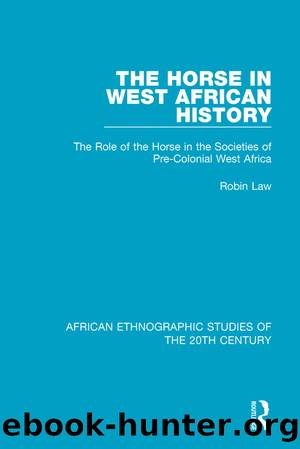The Horse in West African History by Robin Law

Author:Robin Law [Law, Robin]
Language: eng
Format: epub
ISBN: 9781138591851
Barnesnoble:
Publisher: Taylor & Francis
Published: 2020-04-29T00:00:00+00:00
NOTES TO CHAPTER 4
1.Lynn White, Medieval Technology and Social Change (London, 1962), 14â15.
2.Ibid., 19; R. Lefèbvre de Noettes, LâAttelage et le cheval de selle à travers les âges (Paris, 1931), 261.
3.G. W. B. Huntingford, âHorses in Ethiopiaâ, paper presented to the African History Seminar, S.O.A.S., London, 15 Nov. 1963. The words for both âhorseâ and âstirrupâ in the languages of Ethiopia are regularly derived from the Arabie faras and rikab.
4.White, Medieval Technology, 15â27; for the date of its adoption by the Arabs, see 18â19.
5.For the Tuareg term, see Heinrich Barth, Travels and Discoveries in North and Central Africa (centenary edn, London, 1965), III, 760. For the Mande term, see G. Boyer, Un Peuple de lâouest soudanais: les Diawara (Dakar: I.F.A.N., 1953), 96. For other languages eited, see e.g. the following dictionaries: R. C. Abraham, Dictionary of the Hausa Language (London, 1946); A. W. Banfield, Dictionary of the Nupe Language (Shonga, 1914); R. C. Abraham, Dictionary of Modem Yoruba (London, 1958); Henri Gaden, Le Poular: dialecte peul du Fouta sénégalais (Paris, 1914). The Kanuri term was recorded by the present writer during fieldwork in Maiduguri in 1975.
6.Strabo, XVII. 3, 7.
7.For example, F. H. Ruxton, âNotes on the tribes of the Muri Provinceâ, Journal of the African Society, VII (1908), 382, describes the Jukun as âriding on a padâ. For example of blankets used in lieu of saddles (in Air and Oyo), cf. above, pp. 90â91, 105.
8.White, Medieval Technology, 7.
9.W. B. Emery, Egypt in Nubia (London, 1965), 63â9.
10.C. K. Meek, A Sudanese Kingdom: An ethnographical study of the Jukun-speaking peoples of Nigeria (London, 1931), 137 with n. 4; cf. 171.
11.J. H. Greenberg, âLinguistic evidence for the influence of the Kanuri on the Hausaâ, J. Af. Hist., I (1960), 211.
12.For the Mossi term, see L. Binger, Du Niger au Golfe de Guinée (Paris, 1892), i, 496; for Borgu, see Jacques Lombard, âAperçu sur la technologie et lâartisanat baribaâ, Etudes dahomeennes, XVIII (1957), 40; for Yoruba, see e.g. Abraham, Dictionary of Modem Yoruba; the Dagomba term was given to the writer during fieldwork at Yendi in 1975. (Binger suggests that gari is in origin a Fulani term, but the usual Fulani word for âsaddleâ is kirke.) For the Mande term, see Boyer, Les Diawara, 96; for the Fulani term, see Gaden. Le Poular; and also A. Hampate Ba and J. Daget, LâEmpire peul du Maçina, vol. I (1818â1853) (Paris, 1962), 70.
13.Joseph M. Cuoq, Recueil des sources arabes concernant lâAfrique occidentale du VIIIe au XVIe siècle (Paris, 1975), 77.
14.Ibid., 271 (al-âUmari), 304 (Ibn Battuta).
15.Ibid., 270 (al-âUmari), 320 (Ibn Battuta).
16.Ibid., 277.
17.Mansa Musa constructed prayer grounds and Mosques in Mali, and attracted Muslim jurists and an Andalusian poet to settle in the country: ibid., 263 (al-âUmari); ibid., 346â7 (Ibn Khaldun).
18.ibid., 271.
19.Antonio Malfante, in G. R. Crone (trans.) The Voyages of Cadamosto and Other Documents on Western Africa in the Second Half of the Fifteenth Century (London, 1937), 87.
20.Gomes Eanes dâAzurara, Chronique de Guinée, trans. L. Bourdon and R. Ricard (Dakar: I.F.A.N., 1960), 215.
21.For the absence of the bit, see e.
Download
This site does not store any files on its server. We only index and link to content provided by other sites. Please contact the content providers to delete copyright contents if any and email us, we'll remove relevant links or contents immediately.
| Historic | Information Systems |
| Regional |
Man-made Catastrophes and Risk Information Concealment by Dmitry Chernov & Didier Sornette(5883)
The Revenge of Geography: What the Map Tells Us About Coming Conflicts and the Battle Against Fate by Kaplan Robert D(3995)
Zero Waste Home by Bea Johnson(3718)
COSMOS by Carl Sagan(3518)
In a Sunburned Country by Bill Bryson(3457)
Good by S. Walden(3456)
The Fate of Rome: Climate, Disease, and the End of an Empire (The Princeton History of the Ancient World) by Kyle Harper(2976)
A Wilder Time by William E. Glassley(2794)
Camino Island by John Grisham(2739)
The Ogre by Doug Scott(2606)
Organic Mushroom Farming and Mycoremediation by Tradd Cotter(2603)
Human Dynamics Research in Smart and Connected Communities by Shih-Lung Shaw & Daniel Sui(2448)
Energy Myths and Realities by Vaclav Smil(2409)
The Traveler's Gift by Andy Andrews(2333)
9781803241661-PYTHON FOR ARCGIS PRO by Unknown(2297)
Inside the Middle East by Avi Melamed(2283)
Birds of New Guinea by Pratt Thane K.; Beehler Bruce M.; Anderton John C(2205)
A History of Warfare by John Keegan(2141)
And the Band Played On by Randy Shilts(2087)
